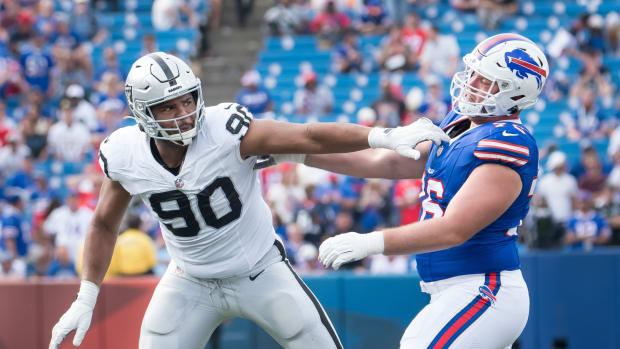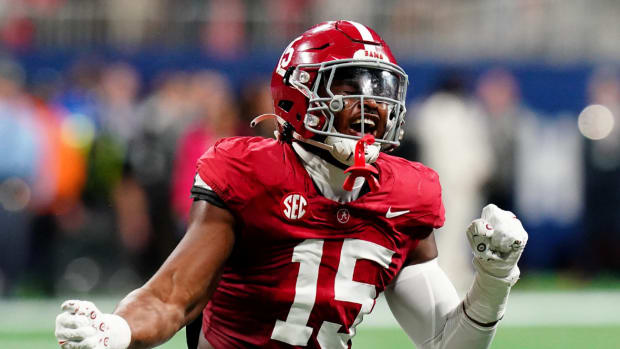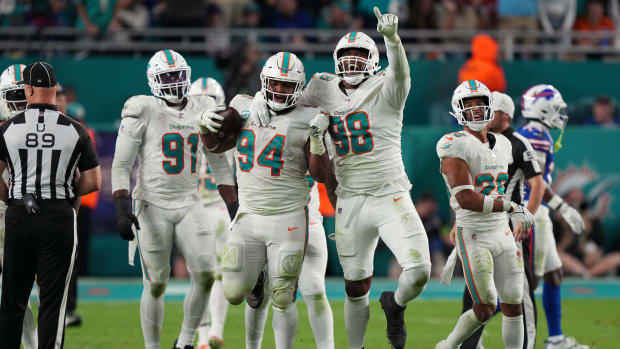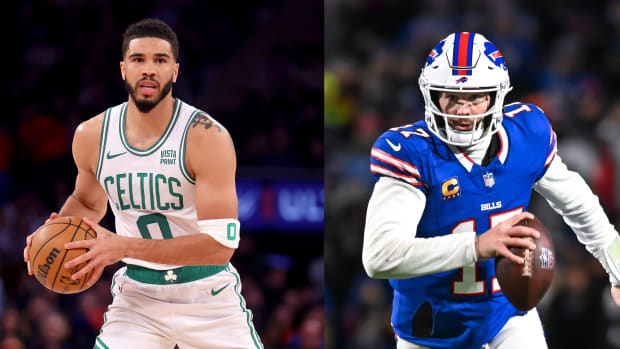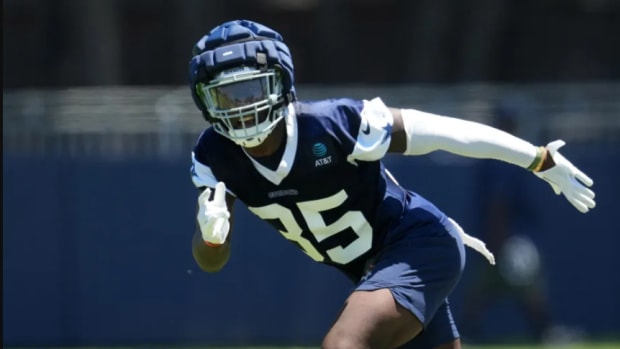What Are the Cowboys Worth to Dak?
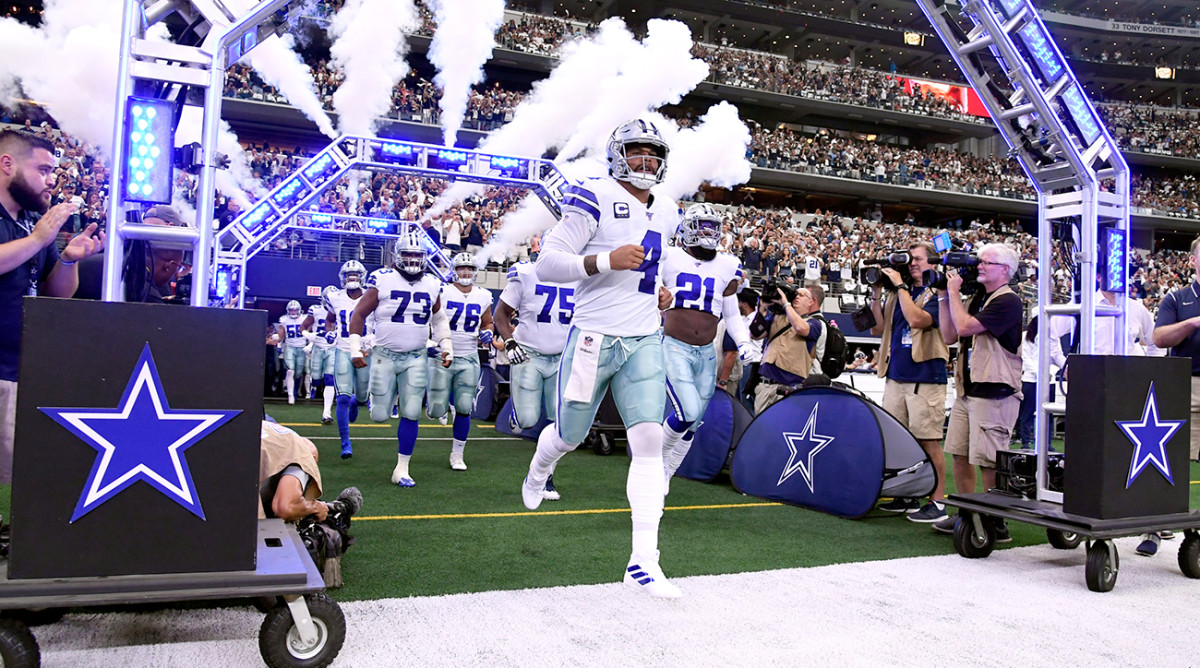
This story appears in the Sept. 23, 2019, issue of Sports Illustrated.For more great storytelling and in-depth analysis, subscribe to the magazine and get up to 94% off the cover price. Click here for more.
As lunch wraps up, the Cowboys Club, the social space and restaurant in the team’s Frisco, Texas-based headquarters, is humming along in comfortable silence. Transparent fireplaces in the entryway and near the bar flicker, highlighting the dark, hardwood floors. The pillows on the brown and silver custom-made furniture are all fluffed the same way, indented in the center. There’s an aroma of essential oils, and a spa soundtrack plays from ceiling speakers. Olaf Nicolai originals hang on the walls.
Professionals are finishing their meals or tapping on laptops across the long, rectangular dining and meeting space. They’ve paid a membership fee and survived a rigorous application process—candidates must reapply annually—for the right to be here. Not to mention the right to have access to the field below, where the most popular team in professional sports is holding a practice on this Wednesday afternoon.
There are no phone calls allowed in the Cowboys Club. No pictures. No Instagramming a selfie. Players can come in and mingle with members of the Dallas area elite without fear of getting tapped by an autograph seeker in a replica jersey. Some can even formulate and execute their own plans for life after football in the Club, or across the Italian marble foyer, where a handful of businesses keep office space, or even in the team’s war room, which high rollers rent out for their fantasy football drafts.
The Cowboys Club is just one artery of the Star, 510,000 square feet of glass and concrete that sits at the center of a newly developed shopping and entertainment space in Frisco. Depending on which side of the complex you’re looking at, the Star can appear to be the kind of place where you can attend a conference, watch high school football, discuss an investment portfolio or perhaps store gold bullion. It’s where the Cowboys practice, rehabilitate and game-plan, but it’s also a four-star hotel, a health and fitness center, an outdoor party and event venue, a youth sports field and an office space (Keurig and Dr. Pepper are moving in next door, right behind the practice field). The intent of its mastermind, team owner Jerry Jones, is simple if not explicitly stated: To create a self-propelling universe here in North Texas, a football Green Gables built around the Cowboys brand.
When the Star isn’t bustling it may seem like excess for the sake of excess, taking on almost an Orwellian dystopia vibe. But when the Cowboys are good—and two weeks into the 2019 season, it appears they are—it takes on a different meaning altogether. Star linebacker Jaylon Smith, who signed a six-year, $68.4 million contract extension last month, takes full advantage of the chance to mingle with business leaders and financial experts: “It’s about access man, it’s all about access. And the Cowboys have expedited that access.”
Starting in early spring, the Cowboys embarked on a spending spree, handing over $180 million in guaranteed money to players, most of whom were already under contract. That’s more than the Jones family paid for the entire franchise in 1989. Smith, defensive end DeMarcus Lawrence (five years, $105 million), right tackle La’El Collins (five years, $50 million) and running back Ezekiel Elliott (six years, $90 million) were all locked down before the season-opening win over the Giants. Still on the Joneses’ to-do list: wide receiver Amari Cooper, cornerback Byron Jones and, most notably, quarterback Dak Prescott.
In a league where the biggest contract at a position doesn’t necessarily go to the best player but the star who made his deal most recently, only two of the Cowboys re-signees (Lawrence and Elliott) topped the league in traditional measures that most use to gauge contracts. Elliott’s back-loaded deal comes with significant risk for a running back. Smith, meanwhile, leapt at the chance to cash in while he still had two years remaining on a particularly restrictive second-round rookie deal, but he did not reset the top of the linebacker market. Collins got a significant percentage of guaranteed money relative to others at his position (70%), but from a team perspective it’s a reasonable deal considering the inflated market for offensive linemen.
How is all this possible in a salary-capped system where the top players almost always dig in until they get the best money for their position? While every situation is different, part of the answer lies in the history of the Cowboys franchise. Long before there were guardrails on what each team could spend, Dallas was known for slipping in a house, horse trailer, rental car or steakhouse gift card to get its best talent to sign for less and for longer. When the Joneses took control, that philosophy evolved into this southern utopia; a network of perks that include that private social club, isolated passageways to the player valet, soaring jersey sales (thus, more commission money), retail space in the pro shop for passion projects and the underlying promise that, if you succeed here, you’ll never have trouble finding lucrative work once your career is over.
One agent familiar with the Cowboys’ pitch warns that much of it is hyperbole—a fever dream of success that can only be attained by the NFL’s equivalent of the “one percent.” Still, in Frisco it’s hard to walk a few feet without bumping into a convert who believes in the almighty power of the Star.
“The players know if you can put a team like this together and win Super Bowls, they’ll have probably six-figure autograph deals for the rest of their lives,” says another agent who has represented Dallas players in the past. “[The Cowboys] don’t slam it down anyone’s throat, but they let people know: If you stay here and good things happen, you’re all going to be able to make money when you’re done playing.”
Prescott, a middle-tier starting QB through his first three NFL seasons, is off to a scorching start at the helm of a revamped offense. He can realistically ask for the largest contract in NFL history. But first, the franchise is hoping he asks himself this: How much is being a Dallas Cowboy worth?
Even back in the 1960s, when the players practiced adjacent to a blue tin shack off the North Central Expressway and needed to work summer jobs, the team sold itself as a legacy brand. You’ll thank the good Lord for making you a Cowboy.
Hall of Fame executive Gil Brandt, the architect of the Cowboys of the 1960s, ’70s and ’80s, used to challenge players during difficult negotiations: Either play with a star on your helmet or—he’d gesture down the road toward a Texaco gas station, with its similar logo—play with a star on your work uniform. He kept boilerplate contract incentives on Post-It notes and simply slapped on different ones to the end of deals to close them faster.
Coach Tom Landry ranked his players in order of importance and asked only that the salaries align. Those who wanted more, like All-Pro cornerback Everson Walls, remember the effort that went into plotting their raises at a time when the threat of free agency was not on the table. One night, after a series of tequila shots with teammate Ron Springs, he decided to give up on his agent’s frutiless negotiating and stage his own retirement. Springs would spy at training camp practice to gauge Walls’s leverage based on his backups’ performance.
Finally, Brandt and the Cowboys broke down to give him $5.1 million over the next three years. “But only because things went crazy because I wasn’t there,” Walls says.
At the same time, the team was laying the groundwork for what would be years of creative player management. Timmy Newsome, a sixth-round pick out of Winston-Salem State, remembers Brandt signing him for $30,000 in 1982—a paltry sum compared to what other running backs were getting, he guesses now. The kickback came in a connection Brandt made to a local software design company, which would allow Newsome to pursue his passion for computer engineering. Newsome could work there five days a week in the offseason, then resume once the Cowboys were knocked out of the playoffs. He kept the gig for nine years until he retired, then opened his own business providing software for the wholesale and distribution industry, Newtec Business Solutions, which he still runs today in Dallas.
Newsome liked the way the team enhanced his life. On road trips Brandt would bring car dealers and home builders and restaurant owners, with the understanding there were freebies and endorsements to be had. Even the least recognizable Cowboys would barely open their wallets during the season. Movies at the United Artist. Dinner at Tony Roma’s Steakhouse (alcohol not included). A free dealer car to drive around. New clothes and a watch for going on a radio show.
“And I wasn’t even a star,” Newsome said. “I just happened to be on the football team. There were guys who got a lot more than I got.”
Here was a franchise eager to help its players supplement their income, Here, too, was a front office ever ready to use its leverage, even calling high school coaches and college coaches and asking them to talk some sense into their former charges. Or to use the reach of the Cowboys Network television channel to paint the players as unreasonable or greedy to a fan base who couldn’t fathom someone turning down a $30,000 deal.
In 1986, Leigh Steinberg, then the agent of a first-round holdout Mike Sherrard, got a call from Joel Bailey, the Cowboys’ VP of Administration, who was on the tarmac at Los Angeles International Airport. Bailey had a strategy for settling on a deal with the UCLA receiver before the Cowboys’ first preseason game. “Bailey wanted to meet right there at LAX,” Steinberg says, laughing.
“I would bring my client with me and we’d flip a coin. I presented it to my client and he said ‘Are you crazy?’ But that was them. There were no rules. It was the wild, wild west.”
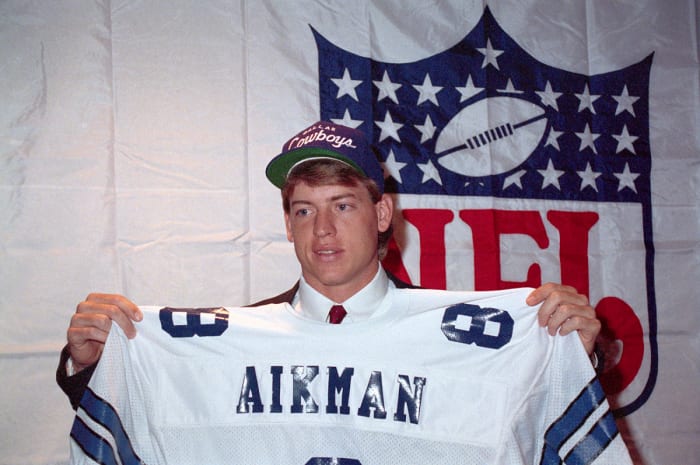
Aikman was the expected No. 1 overall choice of the 1989 draft, but that didn't mean contract negotiations lacked drama.
Bettman/Getty Images
A few years later, Steinberg’s introduction to Jones, contract negotiator, came in the lobby of a Dallas airport hotel around midnight, just a few months before the 1989 draft. The entire world knew the Cowboys were drafting Steinberg’s client, UCLA quarterback Troy Aikman, with the No. 1 pick. There was a frenzy in Dallas called Aikmania.
Steinberg remembers them talking with purpose. High-minded ideas about the agent-owner relationship. The future of the league, and what it could become with the proper vision. What they did not discuss, according to the agent, was the price to sign Aikman, which is why, after Steinberg flew home, he was surprised to read an interview Jones gave.
“And Jerry said ‘Well, they better lower their asking price—they better cut it in half,’” Steinberg recalls. “But we’d never talked about a contract at all.”
This was the Jones capable of being both reviled and beloved—something that those who negotiate with the Cowboys insist is mostly just ol’ boy media bluster from a person who would rather do every deal with a handshake. Jones, not coincidentally a champion of NFL Network, consistently uses negotiations with high-profile players to create and feed the news cycle, even spinning that theater off into a business itself. During Elliott’s contract holdout this summer, in which he missed all of training camp, Jones made a joke about his absence: “Zeke Who?” Elliott’s agent, Rocky Arceneaux, told reporters the remark was disrespectful. A few weeks later everyone was celebrating a new contract and Jones was peddling Zeke Who? T-shirts at the pro shop for $29.99 (with proceeds going to the Salvation Army).
It’s not as if we couldn’t see that coming. Before Jones signed Aikman to his second deal, in 1993, he told Steinberg in a heated phone call that “this dog won’t hunt,” and that “they passed ‘fair’ about $4 million ago,” when the agent pitched his desired figure. A few weeks later they were selling helmets to commemorate the $50 million contract, with Jones’s, Steinberg’s and Aikman’s signatures on it.
Jerry’s son Stephen, along with vice president of player personnel Will McClay, director of football administration Todd Williams and salary cap director Adam Prasifka are more frequently viewed as the faces of the inside-football operation now. When asked if they’ve evolved since their early days as the league’s scrappiest promotion roadshow, Stephen says, “You’d like to think so.” Jerry always told him that if you don’t get better, you’re getting worse. Stephen says this Xanadu they built in three years over vacant grassland in Frisco, which just 20 years ago had a population of a few thousand—it’s now 190,000—is evidence of that. The idea that players with increased financial awareness could have a small business network attached to the facility did not happen by accident.
“Whether it’s misplaced or not, I know this: We haven’t won a Super Bowl in 23 years, which just kills me, and it kills Jerry just as much,” Stephen says. “But you know, we’re still the most valuable brand, most valuable team in sports. Five and a half billion. No. 1. Above all the soccer teams, the Yankees. And being involved with that is valuable since a lot of these guys talk about themselves in terms of their brand.”
It’s why Stephen says he doesn’t lose sleep when he’s trying to get three of the four players who signed long-term deals this offseason to “buy in” on what they were selling—even though the pressure for a great player to become the highest-paid at his position is significant. “We’re trying to talk all of these guys into—Hey, let’s not take every last penny here,” Jones says. “That’s why the deals can’t get done right away. We’re trying to convince the Daks and Amaris and Zekes that hey, we need to spread the money around. This is a distribution dilemma here.”
Jones cites Elliott’s extension as an example of a player’s understanding of the need for financial flexibility. A deeper look at the contract reveals that Elliott will have to stay healthy and to remain an indispensable part of Dallas’s offense—a tall order for any workhorse back—in order to truly cash in. About 30% of the total in the announced deal comes in the final two years when, at least according to the current terms, there is no guaranteed money. So, by making Elliott’s annual payout higher at the end, the average allows Elliott to claim the title of highest-paid running back in terms of average salary, yet keeps his actual base salary relatively low over the next two years at $6.8 million and $9.6 million.
“I think Zeke bought in and gave us the terms we wanted on the front end of his contract,” Jones says. “You’ll look at where it compares to the other backs, a lot of the money comes at the end of his deal, so he gets his [average salary per year] average up. He got that. He said I understand what y’all are trying to do. He knew we needed him to take a little less on the front end.”
Myriad opinions have emerged on the latest slate of deals. Yes, the back end of Elliott’s deal is light on guarantees, but, with a season and fifth-year option remaining on his rookie deal, he pocketed roughly $29 million at signing and $50 million in total guarantees instead of getting run into the ground and cast away into free agency with nothing. No, Smith is not the highest-paid inside linebacker in football, and he could have been when he hit unrestricted free agency in two years, but Dallas bought him out of restricted free agency. A player whose career nearly ended after a catastrophic knee injury at Notre Dame now has financial security.
Stephen says, “We’re not saving the Joneses any money,” which is a line that nearly every agent and player has heard from every team in the NFL. They have to gauge the potholes and risks for themselves. The Cowboys are just trying to make their operation seem like a breezy, five-star resort compared to everyone else’s.
“I mean, we’re looking at a quarterback contract for Dak that’s going to have him guaranteed 100-plus million dollars,” Stephen says.
It’s Thursday before the Cowboys’ 31–21 win at Washington and Dak Prescott is behind a phalanx of notepads, tape recorders and television cameras. He is wearing a white, snap-back mesh hat with the team’s star logo front and center. Behind him, his helmet is displayed sideways.
He is patient and thoughtful but does bounce up and down a bit when the subject of his new deal comes up. “I have a great team, great agents, who are handling that,” Prescott says. “My focus is all in on this team. [The deal] will get done in due time.”
He is perhaps the greatest case study for this idea that you can make more simply by being a Cowboy. A fourth-round pick in 2016, Prescott is considered a quality starter but is rarely spoken of in the same terms as the league’s top-end quarterbacks. On the field, he has had much more in common with middle-class QBs such as Derek Carr, Jimmy Garoppolo and Kirk Cousins than with superstars Tom Brady, Aaron Rodgers and Patrick Mahomes. Yet marketing professionals in the sports business estimate that Prescott’s endorsement money—from Pepsi, Tostitos, Campbell’s Chunky Soup and Beats, among others—is in the tens of millions more than what a comparable player would get on another team. (ESPN recently reported Prescott’s endorsement deals, combined with loss-of-value and disability insurance policies, are valued at more than $50 million.) On one hand, it’s easy to wonder if he joined a potentially quarterback-needy team like the Broncos, Titans or Bucs, a large portion of that would evaporate. However, skeptics on the marketing side point to Mahomes as an example of a highly marketable young star playing in a small market (Kansas City). Plus, Prescott has already established himself as a desirable pitch man; not to mention, he is approaching the next level of stardom on the field.
Opinions about this vary inside the locker room. The lure of the Star isn’t necessarily for the players who aren’t stars themselves. One newer veteran player says that it was not part of the pitch he received from the team, or at least hadn’t gotten it yet. It’s also not for everyone. Another player said that after football he looked forward to leaving the Cowboys’ ecosystem, heading home to do his own thing.
Others, like Smith, embrace the options that Dallas presents. When asked about his post-NFL plans, he holds up both hands, as if cradling a deep-dish pizza. “There are four quadrants: the employee, the self-employed, the business owner and the investor,” he says. “And right now I’m operating out of three quadrants. So it’s pretty good.”
Smith is doing advertisements now for Reliant, the franchise’s energy partner. He also has a deal with the team’s pro shop to carry his line of sunglasses. When asked about the resources at his disposal, he gestures to the offices above the locker room, where, on the top floor, sits Jerry Jones.
“You just have to go upstairs,” he says.
It’s a dilemma all of Dallas’s best players will inevitably have to face as this sprawl continues to grow and their grip on players tightens. Frisco chamber of commerce president Tony Felker says that Jerry Jones is always pushing the area to be aggressive. For example, Jones wanted it to become a test site for Uber’s piloted drones, which would fly people straight from the Dallas/Fort Worth airport into his Cowboys village downtown.
Imagine being a young player having to decide where to spend the rest of your working life. There’s Darren Woodson and Emmitt Smith walking business clients through their offices in the Star. There’s the restaurant of a former Cowboys, Drew Pearson, next to the Chik-Fil-A at the airport. There’s all the old players, signing autographs before games or hanging at watch parties or teeing it up for golf outings, reliving the greatest moments for the fans who can’t get enough. There’s the wall inside the facility, with Romo and Moose and Troy and Jimmy in their broadcast suits and ties.
Imagine drinking all that in while remaining sober-minded about what’s best for you. And still, you might ask yourself: Why should I be anywhere else?
• Question or comment? Email us at talkback@themmqb.com.




































